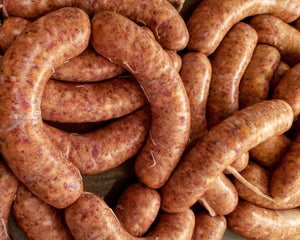10 Tips & Tricks for Better Homemade Sausage
There are few things more satisfying than slicing up a sausage you made with your own two hands. From prepping your meat and seasoning to stuffing and storing, we understand the effort put into every single link. Whether you're new to sausage making to an all-out pro, our top tips and tricks will ensure you have optimal, tender, juicy sausages at the end of your endeavor.
1. Keep it Chill[ed]
Freeze grinder parts the night before sausage making. Freeze meat to 30-40 degrees day of to prevent smearing. You don't want it frozen, just as cold as possible to maintain a good texture and visible fat separation in your finished product.
2. Season Before the Grind
Let the grinder do some of the mixing for you. Depending on the seasoning, you can season after your first pass through the grinder and let the second pass do a lot of the mixing for you. If the seasoning you’re using has whole pieces like crushed jalapeno, we recommend adding your sausage seasoning at the end while adding your liquid, encapsulated citric acid, and high temp cheese.

3. Mix it Good [Enough]
Certain sausages require different levels of mixing. Bratwursts and other fresh link should be mixed just to distribute seasoning, water and add-ins. Hot dogs, bologna and other emulsified sausages need to be mixed until tacky for adequate protein extraction.
4. Taste Before You Case
You certainly don't want to go through all of the effort of grinding, flavoring, stuffing, twisting and smoking to end up with a less than stellar sausage. That's why we recommend always frying up a patty of seasoned sausage before you load it into your stuffer.
5. Run Water Through Casings
Once you’ve soaked your sausage casings in warm water, run a little water through the end before placing on the stuffing horn. This will open up the end of the casing as well as lubricate the inner portions to allow it to thread easily.
6. Prevent Sticking with Water
Lightly coat a metal sheet pan or surface underneath your stuffer with water to prevent the casings from sticking as they come off the stuffer. You don't want so much water that they slide right off the surface but enough that they can glide away without sticking together, causing blowouts and breakage.

7. Tap Casings to Prevent Air Pockets
Whether on or off the horn, air pockets in the casings can be unavoidable. If you’re seeing a decent amount of air building up around the horn, tap the casings with the dull side of a knife or sausage pricker to release the air (don’t worry, this won’t cause any blow-outs). Once your sausage has been cased, use the tip of a knife or sausage pricker to release any air pockets, preventing fat pockets and flame ups on the grill.
8. Clean the Stuffer with Ice
Get every last bite of sausage out by running some ice cubes through your stuffer or grinder. This is especially helpful if your stuffer doesn't come with a cleaning pipe or smaller horn. You can also use a wooden diameter to push any remaining meat from the horn, just don't throw the meat away! This is the perfect opportunity to fry up some brat burgers or hot dog patties.
9. Sleep On it
Letting your sausage rest overnight certainly isn’t required, but it does help develop flavor and, if you’re using a cure, color. Even if you plan on freezing your brats we still recommend letting them rest in the refrigerator overnight to let those flavors meld.
10. Grill it Low & Slow (& Don’t Boil!)
Don't be tempted by the simmering vat of beer and onions. Boiling your brats will only render out any of the fat you worked so hard to get into your sausage. The best way to cook sausage is low and slow over indirect heat. If you're using ground pork, cook those over indirect heat until the internal temperature reaches 160 degrees F. You won't believe the difference it makes!
Hungry for more? Check out our killer sausage recipes & other sausage making tips!


